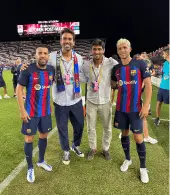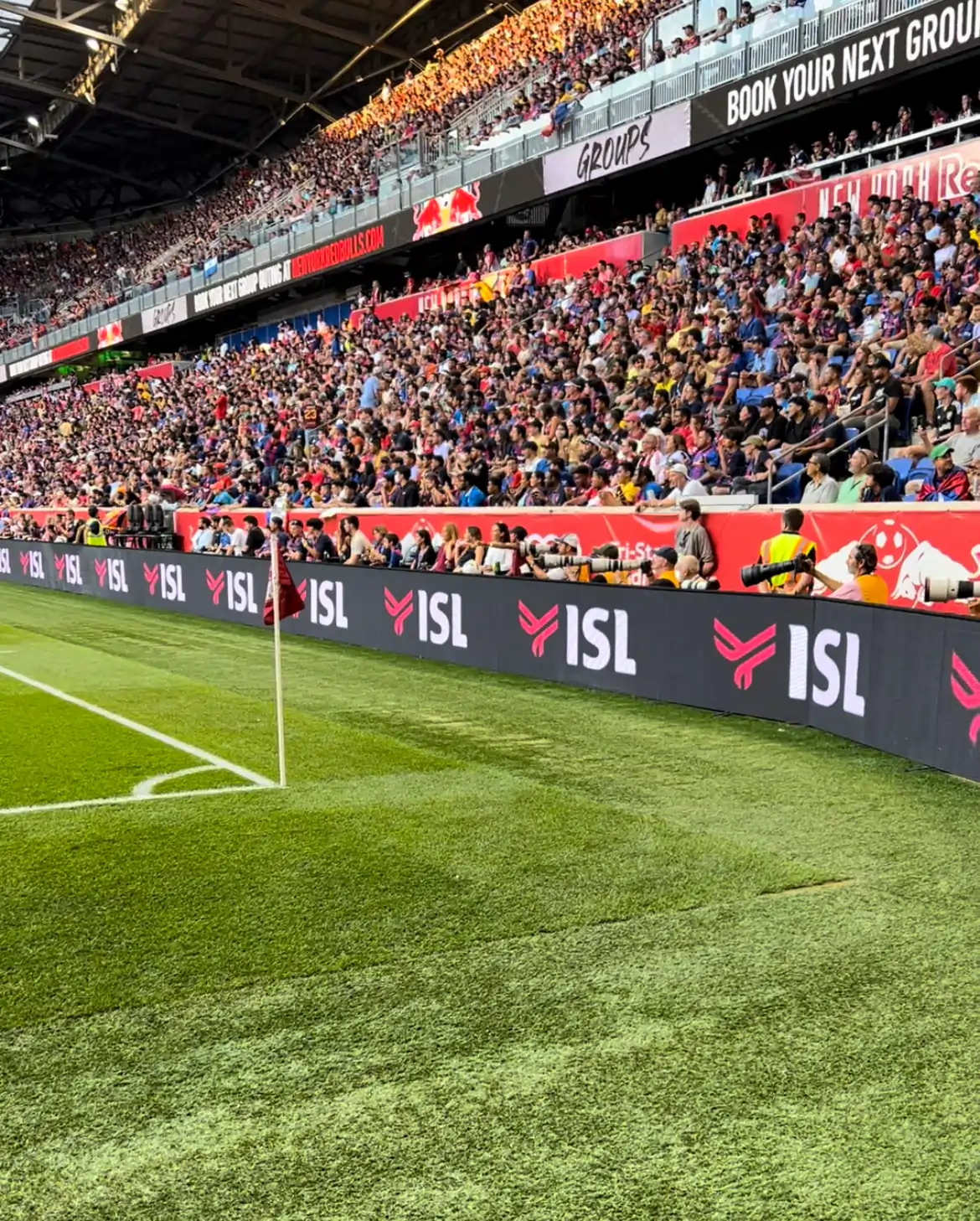




breathe
soccer







Hantec Markets, a global leader in financial services, proudly announced its official sponsorship of Atlético de Madrid and Fortaleza Esporte Clube, two iconic football clubs representing the best of European and South American football. This dual partnership reflects Hantec’s deep commitment to excellence, teamwork, and a global vision for success.
Atlético de Madrid, one of the most successful and celebrated clubs in Europe, and Fortaleza Esporte Clube, a rising force in Brazilian soccer, embody values that align closely with Hantec’s own—passion, perseverance, and ambition.
Through these collaborations, Hantec aims to bridge the worlds of sport and finance, offering unique experiences to both football fans and traders. From exclusive content and special promotions to co-branded campaigns and match-day activations, this partnership is designed to inspire and connect global communities through shared passion.
With a presence in over 12 countries, Hantec continues to invest in sport as a powerful platform to create authentic impact and meaningful engagement across cultures and markets.
We at ISL Agency are proud to have acted as the connecting link that made these partnerships between the brand and both clubs possible.
To celebrate the launch of X CRAZYFAST, the latest boot release from Adidas packed full of ‘AERO’ innovations, Adidas Spain gave the experience of a lifetime to the top Spanish content creators.
With all eyes on Miami after Lionel Messi’s arrival at Inter Miami CF, the city was the perfect choice for Koko DC, Adri Contreras, xBuyer, MiniBuyer, Laura Vizcaino, and Spursito, to live a football experience while promoting the new boots.
We used all of our expertise about North American football, the club, and the city, our home in the USA since 2018, to provide them with an amazing visit to Miami and unforgettable football moments.
ISL arranged for influencers exclusive access to the Florida Blue Training Center, Inter Miami’s training grounds, where they spent an afternoon playing and capturing some incredible content for their social media.
For our Managing Partner, Marc Segarra, having the brand and influencers coming from Spain makes the activation even more special: “It is always nice to welcome people from our country to our new home in America and be able to show them the access we have here in Miami and our relationship with Inter Miami. We are pretty excited that they have trusted us and we can make everybody feel at home.”
On October 27th, the group had another VIP experience, this time to watch Inter Miami in action in the Lamar Hunt US Open Cup final!
As they witnessed Houston Dynamo’s victory by 2×1 at the DRV PNK Stadium, the influencers enjoyed an extraordinary panoramic view of the pitch, premium service executive, and food & beverage.
It was a pleasure to be a part of such an unforgettable experience!
Nicole León, ISL Marketing Director, unveils the playbook on how sports properties harness and can further leverage digital marketing in their international expansion strategies. Join us for an insightful discussion as Nicole shares key insights and addresses crucial questions, shedding light on the strategies shaping global success in the digital era.
The shifts in consumer behavior within the sports industry are characterized by a substantial move towards non-traditional media channels driven by the acceleration of digital adoption. Approximately 40.7% of global sports fans now choose to stream live sports events through digital platforms. This trend signifies a significant departure from conventional methods of sports content consumption. Furthermore, there is an increased appetite for additional sports content, both related and unrelated to live matches, across an expanding array of platforms.
The demand for content related to live events, such as match announcements, short-term content, and highlights, is nearly as high as the demand for the events themselves. Similarly, non-live sports content, including docuseries and behind-the-scenes footage, has gained traction, attracting not only existing fans but also new audiences. Multi-screen viewing activities have become more prevalent, with the general population increasing its engagement in activities like social media, texting, gaming, and ordering food by an average of 5%, doubling to 10% among Gen Z, even during significant live events.
These shifts emphasize the need for brands and sports rights holders to stay connected to evolving consumer behaviors. As channel and device fragmentation continues to rise, adapting strategies to meet consumers on the right platforms and in the right ways becomes critical for successful engagement and international expansion.
The digital media platforms present football clubs with new avenues to connect and engage with fans in innovative ways directly. The immediacy of these platforms facilitates real-time communication, fostering a sense of community as fans actively participate in conversations, polls, and live events. Additionally, the global reach of digital media allows clubs to transcend geographical boundaries, connect with international audiences, and create a diverse and inclusive fan base. This not only enhances the club’s brand globally but also enables cultural exchange among fans from different regions.
Furthermore, digital platforms enable football clubs to deploy creative engagement methods, such as virtual events, exclusive behind-the-scenes content, and interactive initiatives. These strategies not only capture fans’ attention but also deepen their emotional connection to the club. The ability to personalize content delivery based on fan demographics and interests ensures a more targeted and meaningful engagement. Moreover, the analytics provided by digital platforms empower clubs to understand fan behavior, refine strategies, and make data-driven decisions, continually enhancing the overall fan experience.
In essence, digital media platforms are a dynamic tool that enables football clubs to forge direct connections, foster global communities, and explore innovative avenues for fan engagement.
The biggest challenge for sports properties in digital marketing lies in the fragmented digital landscape, making capturing and retaining fan attention increasingly difficult. As the digital space continues to diversify with various platforms and channels, reaching and maintaining a consistently engaged audience becomes a complex task for sports properties. The competition for fan attention across social media, streaming services, and other digital avenues requires strategic efforts to cut through the noise and deliver compelling content that resonates with diverse audiences.
In the fight for fan attention, the inherent power they possess to connect with fans and cultivate lifetime loyalty makes sports properties stand out. The emotional connection that fans develop with their favorite sports transcends mere fandom; it becomes a deeply ingrained aspect of their identity. This enduring loyalty provides sports properties with a unique advantage in capturing and retaining audience attention in the highly competitive digital landscape.
Additionally, the ability of sports properties, especially clubs, to create appealing and authentic storytelling sets them apart. Effective storytelling goes beyond the game itself, offering narratives that resonate with fans on a personal level. Whether through highlighting players’ journeys, historic moments, or community engagement, authentic storytelling fosters a deeper connection and emotional investment, making sports properties more memorable and compelling in the eyes of their audience.
Attracting younger fans demands a multifaceted approach for sustained engagement and growth. Football clubs can strategically optimize their digital presence by embracing popular platforms like TikTok and Instagram, tailoring content to the dynamics of each channel. Collaborating with influencers who resonate with the target demographic adds authenticity to the club’s messaging, while interactive content fosters active engagement. Aligning the club with broader cultural trends ensures relevance, and leveraging player stories and global community building enhances the overall fan experience.
However, the synergy between digital initiatives and physical engagements with clubs globally amplifies the impact of a young target. Expanding soccer clubs beyond their own territory through initiatives such as Summer Camps, Academies, and others not only fosters a sense of community but also provides tangible, real-world experiences, bridging the gap between the digital realm and reality.
These physical initiatives, complemented by digital ones, not only strengthen emotional ties but also offer opportunities for talent development, allowing clubs to identify and nurture young talents globally. By combining digital and physical strategies, football clubs create a comprehensive approach that reaches young fans on multiple levels, solidifying the club’s presence in their hearts and minds for the long term.
Having a fan base in different countries significantly expands clubs’ opportunities to generate new revenues. For European clubs, building a global fanbase serves as a strategic move to diversify their supporter base, reducing dependence on a single market. By strategically engaging fans through social media, targeted merchandise offerings, fan events, and local partnerships, clubs can cultivate a passionate and loyal following across borders.
A growing global fanbase not only enhances the club’s brand on an international scale but also contributes substantially to long-term sustainability. This diversified support base brings in additional revenue streams through various channels, including increased ticket sales for international matches or pre-season tours, elevated merchandise purchases from fans worldwide, and a boost in digital subscriptions for exclusive content and match streaming. The expansion into new markets not only broadens the financial landscape for clubs but also strengthens their overall resilience and market position in the dynamic world of football.
Developing relationships in other countries can give European clubs access to a vast talent pool. The American football landscape, for instance, has been evolving rapidly, with increased investment in youth development, academies, and professional leagues. By establishing partnerships with American clubs, scouting networks, or investing in youth academies, European clubs can tap into the American talent pool and identify potential players for their teams.
It is important to first understand the market and the culture the club wants to enter; it is not the same to expand in China and the USA, for example. Then, clubs have many possibilities for doing that, from local Summer Camps to international tours and pre-season friendlies with local clubs.
The current sports business landscape in the country, hosting the next FIFA World Cup, Olympics, and other relevant soccer events, presents substantial opportunities for European football clubs.
The United States represents a large and lucrative market where European clubs can strategically position themselves to capitalize on various revenue streams. European clubs can effectively tap into the American market by emphasizing key metrics such as revenue, sponsorship deals, and partnerships. The USA’s vast consumer base, robust economy, and deep-rooted passion for sports create significant opportunities for clubs to diversify their revenue sources beyond their home markets. Exploring avenues like merchandising, licensing agreements, and digital partnerships in the US can lead to additional income streams. Moreover, the increasing popularity of European football in the USA, driven by the growing fanbase and interest in major international competitions, further amplifies the potential for European clubs to strengthen their market presence and financial stability in the American sports business landscape.
The world is watching as football takes over the USA, which is happening not only due to Messi’s arrival but also because of the continuous investment and structuring of their male and female national leagues, the MLS and the NWSL, respectively, and the rising numbers of football, or soccer, fandom all around.
To achieve this status, USA football clubs and leagues have demonstrated excellent marketing and financial strategies, offering valuable lessons for more traditional European leagues.
Fan Engagement
MLS excels in fan engagement through various initiatives, including interactive fan experiences, social media, and community involvement. The marketing and promotion in North America and beyond also stands out.
Angel City FC, an NWSL club with a majority female ownership, is an exemplary model for building a community within a football club from the ground up. The MLS itself is committed to attracting younger fans and creating innovative content, as evidenced by its recent partnership with TikTok.
Sports properties all around the world can be inspired by such activations to expand their global reach and attract new fans, connecting with them on a personal level and building a more engaged and passionate fanbase.
Stadium Atmosphere
While there’s nothing quite like South American hinchas, the MLS and the NWSL have worked on creating a vibrant and family-friendly stadium atmosphere. Attention to every detail enhances the matchday experience, making it more comfortable and special for the fans. Austin FC, one of MLS’s clubs with the most engaged community, also does that by promoting activations like Pride Night.
North Americans have always been industry leaders when it comes to blending sports and entertainment. Basketball has exemplified this approach and become a global benchmark with its fast-paced on-court action, spectacular plays, and exciting events that extend beyond sports. This constant pursuit of the “show” has not only defined the USA sports experience but has also influenced how other sports are approached and enjoyed in the country.
Besides providing more entertaining matchday experiences, traditional leagues and clubs currently face the challenge of improving stadium facilities and promoting fan engagement. The USA offers valuable lessons on how to enhance the overall atmosphere.
Financial Transparency
American leagues have clear guidelines to ensure the league is financially sustainable, with teams following current regulations and promoting transparency. European football can benefit from such measures to ensure that clubs maintain financial stability and comply with fair play.
However, regarding tradition and technical quality, the USA draws much inspiration from South American and European football, which have paved the way for the league’s continued growth.
Technical Quality and Playing Style
LaLiga is known for its technical and possession-based style of play, Brazil for its creativity, attacking style, and skillful dribbling, the Premier League for its fast-paced and physical matches, and the Bundesliga for its attacking football and development of young talent.
The MLS and the NWSL are on the path to defining their own style of play and can learn from all these leagues how to improve the technical abilities of their players and promote a more attractive, skillful brand of soccer.
Talent Development
Especially in Europe, football academies are professionally structured and continuously develop top-level talent, which helps not only to attract audiences to their own leagues but also to improve the clubs’ finances with substantial fees for the transfer of players.
By investing in developing young talent in their academy systems, MLS and NWSL can produce more homegrown talent. It is crucial for the USA’s national football interest and international attention to create its own star players to guarantee sustainable growth and reduce its current dependency on expensive international signings.
International Scouting
European leagues have been successful in scouting and recruiting top international talent, particularly from Latin America and other parts of the world.
The North American leagues are already on the way, learning how to effectively scout and bring in international stars to raise the overall level of competition.
For over 10 years, ISL has been based in the USA and has developed extensive knowledge of how the sports market operates, specializing in translating business strategies and standards from one continent to another.
This expertise is key to helping European sports properties find perfect opportunities to expand to the USA, bridging the gap between each culture to develop projects that facilitate international growth effectively.